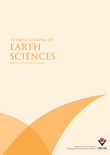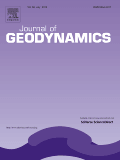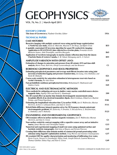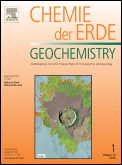
GEOCHEMISTRY GEOPHYSICS GEOSYSTEMS
Scope & Guideline
Exploring Earth's Secrets Through Geochemistry and Geophysics
Introduction
Aims and Scopes
- Geochemical Processes:
Research exploring the chemical processes that govern the behavior of geological materials, including the cycling of elements, mineral formation, and the role of fluids in various geological settings. - Geophysical Techniques:
Utilization of advanced geophysical methods such as seismic tomography, magnetometry, and electromagnetic surveys to understand subsurface structures and processes. - Earth's Dynamics and Tectonics:
Studies addressing the dynamics of Earth's lithosphere, including plate tectonics, volcanic activity, and earthquake processes, often incorporating geochemical and geophysical data. - Paleoclimatology and Environmental Changes:
Investigations into past climate changes and their geological impacts, utilizing various proxies from sediments, ice cores, and fossils. - Hydrothermal and Magmatic Systems:
Research focusing on the interactions between hydrothermal systems and magmatic processes, including the study of ore deposits and geothermal resources. - Isotope Geochemistry:
Application of isotopic techniques to trace geological processes, including the origins of materials, environmental changes, and the timing of geological events.
Trending and Emerging
- Machine Learning and Data Science Applications:
There is a growing trend towards utilizing machine learning and data science techniques to analyze complex geological data, enhance predictive modeling, and improve interpretation of geophysical surveys. - Climate Change and Environmental Impact Studies:
Research focusing on the impacts of climate change on geological processes and environments is increasing, particularly studies that assess long-term changes in sedimentation and geochemical cycles. - Hydrogeology and Groundwater Studies:
An uptick in research related to hydrogeology, particularly in understanding groundwater resources, contamination, and the interactions between groundwater and surface water. - Volcanic Hazards and Monitoring:
Studies focused on volcanic activity, including real-time monitoring and risk assessments, are becoming more prevalent as societies seek to mitigate the impacts of volcanic eruptions. - Geochemical Recycling and Resource Recovery:
Emerging research into the recycling of geological materials and the recovery of resources from waste materials reflects a growing interest in sustainability and resource management.
Declining or Waning
- Traditional Petrology:
Research centered solely on classical petrology techniques is becoming less common, as there is a growing integration of geochemistry and geophysics in studies of rock formation and evolution. - Static Geological Models:
The reliance on static models of geological formations is waning in favor of dynamic models that incorporate real-time geological processes and data. - Single-Discipline Studies:
Papers that focus exclusively on a single discipline without interdisciplinary collaboration are less frequently published, as the trend leans towards integrated approaches that combine geochemistry, geophysics, and other fields.
Similar Journals

NORWEGIAN JOURNAL OF GEOLOGY
Uncovering Geological Insights for a Sustainable Future.NORWEGIAN JOURNAL OF GEOLOGY, published by the Geological Society of Norway, stands as a vital resource in the fields of geology, geochemistry, petrology, geophysics, oceanography, and paleontology. Since its transition to an Open Access model in 2015, this journal has significantly expanded its reach, allowing for greater dissemination of cutting-edge research and insights. With an ISSN of 2387-5844 and E-ISSN of 2387-5852, the journal is committed to fostering collaboration and knowledge exchange among the scientific community. The journal's categorization in the Q3 quartile across various Earth and Planetary Sciences fields underscores its status as a reputable publication, offering researchers, professionals, and students alike a platform to share their findings and advancements in geology. Continuing through its converged years from 2015 to 2024, the NORWEGIAN JOURNAL OF GEOLOGY plays a crucial role in enhancing our understanding of Earth's processes and materials, making it an important reference for anyone engaged in geoscientific research.

TURKISH JOURNAL OF EARTH SCIENCES
Innovating Insights in Earth and Planetary SciencesTURKISH JOURNAL OF EARTH SCIENCES, published by the Tubitak Scientific & Technological Research Council Turkey, is a premier platform dedicated to advancing the field of Earth and Planetary Sciences. With an ISSN of 1300-0985, this journal has been a significant contributor to the international scientific community since its inception in 2002, and is set to continue publishing groundbreaking research through 2024. As a recognized journal in the Q2 quartile of Earth and Planetary Sciences, it ranks #98 out of 195 in its category according to Scopus metrics, positioning it within the 50th percentile of its field. The journal emphasizes peer-reviewed research, providing invaluable insights that facilitate scholarly discourse and promote rigorous investigation into various aspects of the Earth sciences. Although it does not currently offer open access, the journal remains a vital resource for academics, professionals, and students seeking to deepen their understanding of geological phenomena and contribute to the advancement of this essential discipline.

Journal of Volcanology and Seismology
Bridging Academic Inquiry with Environmental ImpactThe Journal of Volcanology and Seismology, published by PLEIADES PUBLISHING INC, serves as a pivotal platform for disseminating innovative research in the fields of volcanology and seismology. With an ISSN of 0742-0463 and an E-ISSN of 1819-7108, this journal aims to contribute to the understanding of geological processes, providing insights that are essential for both academic inquiry and practical applications in hazard management and environmental conservation. The journal spans from 2007 to 2024 and holds a respectable position in the academic community, classified within the Q3 quartile across key categories including Geochemistry and Petrology, Geology, and Geophysics. Despite the absence of an open access model, the journal remains highly relevant, ranking in the 34th Percentile for Geology and the 33rd Percentile for Geophysics, reflecting its commitment to quality and rigor. Researchers, professionals, and students are encouraged to engage with this resource to enhance their understanding and contribute original findings to the ever-evolving disciplines of Earth sciences.

Geosphere
Empowering Geoscientists with Unrestricted Access to KnowledgeGeosphere is a premier open access journal published by the Geological Society of America, Inc., dedicated to advancing the fields of geology and stratigraphy. Since its inception in 2005, this journal has established itself as a critical platform for sharing high-quality research, evidenced by its robust positioning in the 2023 Scopus rankings, where it holds the 12th rank in stratigraphy and 75th in geology. With an impressive impact factor and a commitment to open access since 2018, Geosphere facilitates the dissemination of significant findings to a global audience, making it an essential resource for researchers, professionals, and students alike. The journal's scope includes a wide range of topics related to Earth and Planetary Sciences, encouraging interdisciplinary collaboration and innovation. Based in the United States, Geosphere continues to foster a community dedicated to understanding the Earth's processes and resources, ensuring that it remains at the forefront of geological research.

JOURNAL OF GEODYNAMICS
Transforming Understanding of Earth’s Dynamic ProcessesJOURNAL OF GEODYNAMICS is a leading scholarly journal published by PERGAMON-ELSEVIER SCIENCE LTD, focusing on the dynamic interactions of geological and geophysical processes. With a distinguished impact factor reflective of its significance in the field, this journal operates from the United Kingdom and has been an essential platform for innovative research since its inception in 1984. It encompasses a wide range of topics within Earth-Surface Processes and Geophysics, consistently ranking in the upper quartiles (Q1 and Q2) as per the 2023 category rankings, thereby providing a robust avenue for researchers seeking to contribute to high-impact advancements in these fields. The journal is indexed in Scopus, bolstering its visibility with admirable ranks, including 44th out of 165 in Geophysics. While it does not currently offer open access options, the journal remains pivotal for academics aiming to deepen their understanding of geodynamic mechanisms and foster interdisciplinary collaboration. For over three decades, the journal has served as a cornerstone resource for professionals, researchers, and students eager to explore and publish groundbreaking findings in geoscience.

Geophysics
Fostering Excellence in Earth Science ScholarshipGeophysics, published by the SOC EXPLORATION GEOPHYSICISTS - SEG, is a prestigious journal notable for its significant contributions to the fields of geophysics, geochemistry, and petrology. Since its inception in 1936, this journal has consistently provided a platform for high-quality research, maintaining a strong impact within the academic community, evidenced by its Q1 ranking in these important scientific categories for 2023. With an ISSN of 0016-8033 and an e-ISSN of 1942-2156, it features rigorous peer-reviewed articles that address the latest advancements in geophysics and related disciplines, contributing to a deeper understanding of Earth processes. Although it does not offer open access options, the journal ensures broad dissemination of knowledge and remains essential for researchers, professionals, and students dedicated to exploring energy resources and geophysical phenomena. Its Scopus rankings, including a commendable 22nd out of 165 in Earth and Planetary Sciences for Geophysics, affirm its importance and reach in the academic community. In addition to fostering scholarly discourse, Geophysics plays a critical role in advancing the practical applications of geophysical research, making it a vital resource for those engaged in exploration and environmental studies.

GEOSCIENCES JOURNAL
Fostering Collaboration in Geosciences for a Greener Tomorrow.Welcome to the GEOSCIENCES JOURNAL, a pivotal publication in the fields of Earth and Planetary Sciences and Environmental Science, proudly presented by the Geological Society of Korea. Established in 1997, this journal has become a prominent platform for researchers, professionals, and students, offering a rich collection of peer-reviewed articles that explore a diverse array of geoscientific topics. With an impressive Q2 ranking in both Earth and Planetary Sciences and Environmental Science categories for 2023, it stands as an essential resource in the academic community. Though it operates under a traditional subscription model, GEOSCIENCES JOURNAL remains dedicated to advancing knowledge through rigorous research. Addressed from its headquarters in Seoul, South Korea, the journal aims to foster a deeper understanding of geosciences, encouraging innovation and collaboration in tackling today’s environmental challenges.

Geochemistry
Connecting Research and Innovation in Earth SciencesGeochemistry is a distinguished academic journal published by Elsevier GmbH, focusing on the intricate study of geochemical processes across earth systems. With its ISSN 0009-2819 and E-ISSN 1611-5864, this journal serves as a crucial platform for scholars and researchers eager to disseminate their latest findings in geochemistry, petrology, and geophysics. The journal has established itself within the scientific community, achieving a Q2 ranking in both Geochemistry and Petrology as well as Geophysics, showcasing its significant impact and relevance—ranking 18th out of 165 in Geophysics and 26th out of 154 in Geochemistry and Petrology according to Scopus. From its inception in 1978 to its ongoing contributions through 2024, Geochemistry remains a vital resource for academic discourse and innovation in earth sciences. As an open-access title, it allows for broader dissemination of knowledge, promoting accessibility for researchers, students, and professionals. Whether you are engaged in theoretical research or applied studies, Geochemistry provides the insights necessary to advance our understanding of the planet's chemical complexity.

EARTH AND PLANETARY SCIENCE LETTERS
Illuminating the Path of Earth Science DiscoveryEARTH AND PLANETARY SCIENCE LETTERS, published by ELSEVIER, stands as a premier academic journal in the fields of Earth and Planetary Sciences, Geochemistry and Petrology, Geophysics, and Space and Planetary Science. Since its inception in 1966 and continuing to 2024, the journal has consistently maintained an impressive reputation, ranking in the top quartile (Q1) across several categories, highlighting its vital role in advancing scholarly research. With a Scopus ranking of #4 in both Geophysics and Geochemistry and Petrology, and a notable 97th percentile in multiple Earth sciences categories, EARTH AND PLANETARY SCIENCE LETTERS provides a platform for groundbreaking research, encouraging rigorous investigation and dissemination of knowledge. While not available as an Open Access publication, the journal remains highly accessible to academics and professionals worldwide, providing invaluable insights and fostering discussions that influence the future of Earth sciences. Whether you are a researcher, educator, or student, this journal is a crucial resource for understanding our planet and its processes.

MARINE GEOPHYSICAL RESEARCH
Fostering breakthroughs in geochemistry and oceanography.MARINE GEOPHYSICAL RESEARCH is a prominent journal published by Springer, dedicated to advancing the field of marine geophysics, with significant contributions to geochemistry, petrology, and oceanography. Established in 1970 and currently running its volumes until 2024, this journal operates as a key resource for researchers and professionals focused on understanding the complexities of marine environments and geological processes. With a strong foothold in academic rankings—positioned in Q2 for both Geophysics and Oceanography, and Q3 for Geochemistry and Petrology in the 2023 category quartiles—MARINE GEOPHYSICAL RESEARCH provides a rigorous platform for high-quality research dissemination. Although not an open-access journal, it offers invaluable insights into marine geophysical phenomena, thus appealing to a diverse audience of scholars and practitioners. The journal’s relevance and impact are further underscored by its Scopus ranks, situating it competitively within the Earth and Planetary Sciences domain. Researchers and students seeking to stay abreast of cutting-edge developments and methodologies in marine geophysics will find it an essential addition to their academic resources.